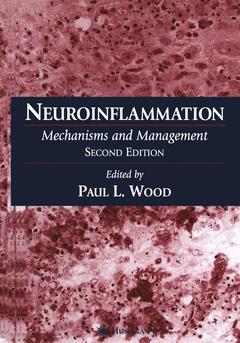Description
Neuroinflammation (2nd Ed., 2nd ed. 2003)
Mechanisms and Management
Contemporary Neuroscience Series
Coordinator: Wood Paul L.
Language: English
Subject for Neuroinflammation:
Keywords
Alzheimer; Parkinson; alzheimer's disease; brain; imaging techniques; receptor; spinal cord; stroke
Neuroinflammation (2nd Ed.)
Publication date: 07-2012
420 p. · 17.8x25.4 cm · Paperback
Publication date: 07-2012
420 p. · 17.8x25.4 cm · Paperback
Neuroinflammation, mechanisms and management 2nd ed.
Publication date: 12-2002
420 p. · 17.8x25.4 cm · Hardback
Publication date: 12-2002
420 p. · 17.8x25.4 cm · Hardback
Description
/li>Contents
/li>Comment
/li>
In this thoroughly updated and revised edition of his much praised book, Paul L. Wood and a panel of leading researchers capture these new developments in a masterful synthesis of what is known today about the inflammatory mediators and cells involved in neurodegenerative diseases. This second edition contains extensive updates on the mediators produced by microglia and their role in neuroinflammatory-induced neuronal lysis. There is also increased coverage of the animal models used in the study of neuroinflammatory mechanisms, of the new imaging methods that allow the noninvasive evaluation of microglial activation in human neurodegernerative disorders, and of the role of neuroinflammation in amyloid-dependent neuronal lysis.
I. Neuroinflammatory Mechanisms.- 1 Microglia: Roles of Microglia in Chronic Neurodegenerative Diseases.- 2 Apoptosis vs Nonapoptotic Mechanisms in Neurodegeneration.- 3 Role(s) of Mitogen and Stress-Activated Kinases in Neurodegeneration.- 4 Roles of Chemokines and Their Receptors in Neuroinflammation.- 5 Neurotoxic Mechanisms of Nitric Oxide.- 6 Chronic Intracerebral LPS as a Model of Neuroinflammation.- 7 Peroxisome Proliferator-Activated Receptor Gamma Agonists: Potential Therapeutic Agents for Neuroinflammation.- 8 Neuroinflammation-Mediated Neurotoxin Production in Neurodegenerative Diseases: Potential of Nitronesas Therapeutics.- II. Stroke and TBI.- 9 Inflammation and Potential Anti-Inflammatory Approaches in Stroke.- 10 Neuroinflammation as an Important Pathogenic Mechanism in Spinal Cord Injury.- 11 Type IV Collagenases and Blood-Brain Barrier Breakdown in Brain Ischemia.- III Alzheimer’s Disease.- 12 Neuroinflammatory Environments Promote Amyloid-? Deposition and Posttranslational Modification.- 13 Microglial Responses in Alzheimer’s Disease: Recent Studies in Transgenic Mice and Alzheimer’s Disease Brains.- 14 The Amyloid Hypothesis of Cognitive Dysfunction.- 15 The Cerebellum in AD: A Case for Arrested Neuroinflammation?.- 16 The Neuroinflammatory Components of the Trimethyltin (TMT) Model of Hippocampal Neurodegeneration.- 17 Inflammation and Cyclo-Oxygenase in Alzheimer’s Disease: Experimental Approaches and Therapeutic Implications.- IV. Multiple Sclerosis.- 18 Experimental Autoimmune Encephalomyelitis.- 19 Neuroimmunologic Mechanisms in the Etiology of Multiple Sclerosis.- 20 In Vivo Imaging of Neuroinflammation in Neurodegenerative Diseases.- V. Parkinson’s and Huntington’s Diseases.- 21 Inflammatory Mechanisms in Parkinson’s Disease.- 22 Neuroinflammatory Components of the 3-Nitropropionic Acid Model of Striatal Neurodegeneration.
Includes supplementary material: sn.pub/extras
© 2024 LAVOISIER S.A.S.
These books may interest you

Cyclin Dependent Kinase 5 (Cdk5) 158.24 €



